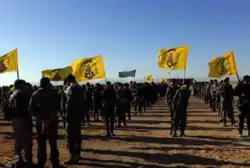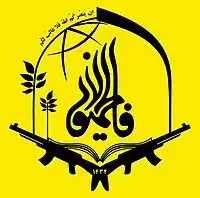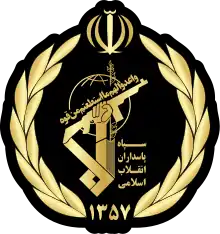Liwa Fatemiyoun (Arabic: لِوَاء الْفَاطِمِيُّون, romanized: Liwā’ al-Fāṭimīyūn, Persian/Dari: لواء فاطمیون or لشکر فاطمیون), literally "Fatimid Banner", also known as Fatemiyoun Division or Fatemiyoun Brigade,[3] is an Afghan Shia militia formed in 2014 to fight in Syria on the side of the Syrian government. The group's officially designated purpose, is the defense of the shrine of Zaynab bint Ali, and to fight "takfiri terrorists" in Syria, which would come to include the Islamic State (IS).[23][24] It is funded, trained, and equipped by the Islamic Revolutionary Guard Corps (IRGC), and fights under the command of Iranian officers.[4] Both the Fatemiyoun Brigade and the Iranian government downplay their relationship with one another, despite clear coordination and the brigade's operation under the auspices of the IRGC.[4] Liwa Fatemiyoun is also closely associated with Hezbollah Afghanistan.[4]
By late 2017, the unit was presumed to have numbered between 10,000 and 20,000 fighters.[3] According to Zohair Mojahed, a cultural official in the Fatemiyoun Brigade, the group suffered 2,000 killed and 8,000 wounded up to the end of 2017 while fighting in Syria.[25] However, other non-brigade sources have put the number of combat deaths lower.[26]
History
Background
The core of Liwa Fatemiyoun is constituted of the fighters of the Shia militia group Muhammad Army (سپاه محمد) which was active during the Soviet–Afghan War and against the Taliban, until its collapse after the Invasion of Afghanistan, as well as the Abuzar Brigade, an all-Afghan Shia militia group who voluntarily fought in the Iran–Iraq War. During the Iran–Iraq war, these fighters were stationed in the mountainous areas of Loolan and Navcheh in the northwestern Iran, as they had experience in mountain warfare and irregular warfare during the war against the Soviets.[27][28][29]
Iran is also known to have established branches of Hezbollah in Afghanistan and Pakistan, with several pro-Iranian groups operating in both countries by the Soviet–Afghan War.[30][31][32]
Operations of Liwa Fatemiyoun
Reports of pro-government Afghan fighters in Syria date back to October 2012.[4] They originally fought in the Iraqi Abu Fadl al-Abbas Brigade before eventually becoming a distinct brigade in 2013.[33] According to news sources affiliated with the IRGC, the group was founded on 22 Urdibihist 1392/12 May 2013.[34] The group's officially designated purpose, according to the Iranian government and affiliated news sources, is the defense of the shrine of Zaynab bint Ali, the granddaughter of Prophet Muhammad, and to fight "takfiri terrorists" in Syria, which would come to include the Islamic State (IS).[23][24] At some point before 2014, Liwa Fatemiyoun was "incorporated" with Hezbollah Afghanistan, a minor political party in Afghanistan.[4]
The Liwa Fatemiyoun became involved in multiple operations throughout Syria, including in Darra, Aleppo, and Palmyra. In March 2016, they fought in the recapture of Palmyra from the Islamic State.[35] In 2017, the unit helped countering a major rebel offensive in northern Hama Governorate,[15] and later aided a pro-government offensive in the Syrian Desert that aimed at reaching the Iraqi border.[16] In course of the latter campaign, Mohammad Hosseini (also known as "Salman") was killed as he stepped on an anti-personnel mine. Hosseini had served as the intelligence chief of Liwa Fatemiyoun's Hazrat-e Fatemeh Zahra Brigade.[36] Following the successful conclusion of this offensive, the Liwa Fatemiyoun took part in the campaign to capture all of central Syria from the IS. Anwar Yawri, another commander of Liwa Fatemiyoun, was killed during these operations.[17] The unit later took part in the Eastern Syria campaign (September–December 2017), and helped to break the Islamic State's siege on Deir ez-Zor.[3]
Throughout their operations in Syria, Liwa Fatemiyoun has sustained numerous casualties. In October 2014, three fighters were captured by the rebel Islamic Front. Their fates are unknown.[37] On 7 May 2015, Iran commemorated 49 fighters of the group who were killed.[38] According to Spiegel Online, 700 members of the group are believed to have been killed in combat around Daraa and Aleppo as of June 2015.[39]
The Washington Institute estimated at least 255 casualties between January 19, 2012, and March 8, 2016.[40] While precise casualty figures are difficult to determine, the brigade is thought to have lost 925 fighters in Syria as of May 2020.[41] These numbers are likely to increase as the Iranian government continues to identify the remains of Fatemiyoun members, sometimes as long as 5 years after their death, and return their bodies to Iran.[42]
.jpg.webp)
On 21 November 2017, Iran declared victory over IS, and subsequently started to downsize Liwa Fatemiyoun. The first troops to be demobilized were the youngest and oldest, as well as those who had exhibited problematic behavior such as indiscipline. The demobilized fighters were sent back to Iran to return to their families and civilian life.[3]
In the course of the COVID-19 pandemic, Liwa Fatemiyoun reportedly began to produce masks and gloves in Iran and Syria, intending to distribute them to poor Syrians. Western observers suspected that this was supposed to boost the group's image and help it in recruiting new members.[43] By late 2020, Liwa Fatemiyoun was still operating in eastern Syria,[44] though only about 500 to 1,500 fighters strong.[12]
Experts differ on what role Liwa Fatemiyoun was fulfilling as of 2020, as the Syrian government had become relatively secure. Researcher Phillip Smyth argued that Liwa Fatemiyoun was supposed to act as Iran's "phantom force" of trained foreign soldiers, ready to be used for possible future interventions. Accordingly, Symth and ex-Herat Province governor Abdul Qayoum Rahim claimed in 2020 that Liwa Fatemiyoun had begun deployment to other localities around the Middle East without providing firm evidence.[12]
Symth and Rahim also claimed that the constant fighting had turned Liwa Fatemiyoun into an elite force, as most of its less capable fighters had been killed or demobilized, leaving only the most experienced and radical ones. Other security analysts argued that there was no evidence for further mass foreign deployments, and that Liwa Fatemiyoun was overall diminishing in numbers and suffering from low morale, as the Iranian government had proven to be slow in granting promised benefits to its fighters.[12]
Organization, supplies and equipment
Liwa Fatemiyoun is led by IRGC commanders and supplied by the Iranian military.[3][45] Its troops are recruited from the approximately 3 million Afghans in Iran,[3][45][5] as well as Afghan refugees already residing in Syria.[6] The recruits are typically Hazara, an ethnic group from central Afghanistan.[6][4][45] The Iranian recruiters for Liwa Fatemiyoun are usually members of the Basij.[46] In August 2016, Iranian official Qurban Ghalambor was arrested by the Afghan government for recruiting fighters for the brigade.[45]

The Afghans are promised Iranian citizenship and salaries of $500–$800 per month in return for fighting (usually a 3-month-long deployment to Syria).[3][21][4][47] Many are refugees[21] and some criminals who choose recruitment over imprisonment or deportation,[47][39][37] though the Iranian government generally claims that they are religiously motivated volunteers.[3][46] The first Liwa Fatemiyoun troops sent to Syria were told that they were fulfilling their "Islamic duty" by defending the shrines of Damascus.[12]
After completing their service, many ex-Liwa Fatemiyoun fighters were frustrated that the Iranian government proved slow in fulfilling all their demands. Most importantly, fighters struggled to secure the promised benefits such as salaries, housing, and jobs due to Iran's difficult economic situation and cases of Iranian officials stalling in regards to payouts. The families of fallen fighters have also struggled to secure benefits and visas.[12]
Though some Afghan sub-commanders of Liwa Fatemiyoun are veterans of several wars, including the Iran–Iraq War and the Afghan Civil War (1996–2001),[3] new recruits of the unit generally lack combat experience.[5] The recruits are given just a few weeks of training, armed, and flown to Syria via the Iraq–Syria–Iran air bridge. These soldiers are used as shock troopers, spearheading numerous important pro-government offensives alongside Iranian, Iraqi, and Hezbollah troops. Most of them operate as light infantry, although some receive more thorough training and can work as tank crews.[48]
Parts of Liwa Fatemiyoun have been trained by the Russian Armed Forces.[3] As the unit is often used in those war zones where the most intense fighting takes place[3] despite its sometimes inadequate training,[5] observers believe that Liwa Fatemiyoun fighters often act as "cannon fodder".[3][5] By 2020, analysts such as Philip Symth argued that the "cannon fodder" troops of the unit had been mostly weeded out, leaving only a hardened core of fighters.[3]
Relationship with Hezbollah Afghanistan
According to researcher Phillip Smyth, Liwa Fatemiyoun and Hezbollah Afghanistan were originally different groups, but showed such great overlap in ideology and membership by 2014 that they had become "incorporated".[4] In contrast, researcher Oved Lobel continued to regard Liwa Fatemiyoun and Hezbollah Afghanistan as separate organizations in 2018, though both were part of Iran's "regional proxy network".[31] Other sources such as Jihad Intel and Arab News have treated the two as the same organization.[6][49] Researcher Michael Robillard called Liwa Fatemiyoun a "branch of Hezbollah Afghanistan".[50]
Accusations of war crimes
According to Human Rights Watch, Liwa Fatemiyoun has recruited child soldiers, some of whom were as young as 14.[46]
Designation as terrorist organization
In 2019, the United States and Canada each declared the Fatemiyoun a terrorist organization.[51] According to then Treasury Secretary Steven Mnuchin, the designation of the Fatemiyoun as a terrorist organization was part of an "ongoing pressure campaign to shut down the illicit networks the [Iranian] regime uses to export terrorism and unrest across the globe.”[52]
See also
References
- 1 2 "Iran mourns 7 Afghans killed fighting for Damascus ally". Daily Star Lebanon. Archived from the original on 3 April 2015. Retrieved 7 May 2015.
- 1 2 yalibnan. "Top Iranian Guards commander, several fighters killed in Syria". Archived from the original on 3 June 2016. Retrieved 6 May 2016.
- 1 2 3 4 5 6 7 8 9 10 11 12 13 14 15 16 17 18 Ahmad Shuja Jamal (13 February 2018). "Mission Accomplished? What's Next for Iran's Afghan Fighters in Syria". War on the Rocks. Archived from the original on 14 May 2019. Retrieved 4 August 2018.
- 1 2 3 4 5 6 7 8 9 Phillip Smyth (3 June 2014). "Iran's Afghan Shiite Fighters in Syria". Washington Institute for Near East Policy. Archived from the original on 11 November 2017. Retrieved 18 May 2022.
- 1 2 3 4 5 AFPC 2017, p. 340.
- 1 2 3 4 "Liwa al-Fatemiyoun". Jihad Intel. Archived from the original on 4 August 2018. Retrieved 4 August 2018.
- ↑ "Syria rebel group denies releasing Afghan prisoners". 23 February 2016. Archived from the original on 24 February 2016. Retrieved 23 February 2016.
- ↑ Sohranas. "More than 50 air raids carried out on Jeser al-Shagour, and the violent clashes continue around hills in Frikah village and al-Alawin checkpoint". Syrian Observatory For Human Rights. Retrieved 9 May 2015.
- ↑ Leith Fadel (2 November 2015). "Syrian Army and Hezbollah Make Huge Gains in Southern Aleppo: Military Operations Begin in Al-Hadher". Al-Masdar News. Archived from the original on 28 March 2019. Retrieved 29 August 2016.
- ↑ Amir Toumaj (3 August 2016). "Iranian military involvement in the battle for Aleppo". The Long War Journal. Archived from the original on 1 February 2017. Retrieved 29 August 2016.
- ↑ "Iran Sent Them to Syria. Now Afghan Fighters Are a Worry at Home". New York Times. 11 November 2017. Archived from the original on 17 August 2019. Retrieved 12 November 2017.
Not only did Iran send smaller units of the Fatemiyoun to cross Syrian borders and fight in Yemen
- 1 2 3 4 5 6 Ali M Latifi (26 September 2020). "'Phantom force': Young Afghans fighting in Syria face uncertain future". Middle East Eye. Retrieved 9 May 2021.
- ↑ "After ISIS, Fatemiyoun Vows to Fight with "Axis of Resistance" to Destroy Israel". Middle East Institute. Archived from the original on 2020-07-16. Retrieved 2020-07-23.
- 1 2 Christoph Reuter. American Fury: The Truth About the Russian Deaths in Syria: Hundreds of Russian soldiers are alleged to have died in U.S. airstrikes at the beginning of February. Reporting by Der Spiegel shows that events were likely very different. Archived 2018-03-04 at the Wayback Machine Der Spiegel, 2 March 2018.
- 1 2 Amir Toumaj (2 April 2017). "Qassem Soleimani reportedly spotted in Syria's Hama province". Long War Journal. Archived from the original on 3 April 2017. Retrieved 3 April 2017.
- 1 2 3 Amir Toumaj (14 June 2017). "Qassem Soleimani allegedly spotted in Syria near the Iraqi border". Long War Journal. Archived from the original on 1 May 2019. Retrieved 15 June 2017.
- 1 2 "Including a Commander, new dead of Fatimioun militia in Syria". Al-Dorar Al-Shamia. 27 July 2017. Archived from the original on 1 August 2017. Retrieved 28 August 2017.
- ↑ "UN aid convoy to make fresh attempt to reach battered Syrian rebel enclave". www.yahoo.com. Archived from the original on 2019-04-19. Retrieved 2018-03-09.
- ↑ "Military commander in the Southern Front illustrates latest developments of Daraa". 22 June 2018. Archived from the original on 18 November 2018. Retrieved 18 July 2018.
- ↑ Joe Truzman (14 February 2020). "IRGC trained militias suffer losses in northwest Syria". Long War Journal. Archived from the original on 17 February 2020. Retrieved 17 February 2020.
- 1 2 3 Mashal, Mujib; Faizi, Fatima (November 11, 2017). "Iran Sent Them to Syria. Now Afghan Fighters Are a Worry at Home". The New York Times. Archived from the original on August 17, 2019. Retrieved November 12, 2017.
- ↑ "شورش مهدی بلخابی؛ نبرد علیه طالب به رهبری طالب". ایندیپندنت فارسی. 19 August 2022.
- 1 2 "لشکر فاطمیون چگونه تأسیس شد؟". مشرق نیوز (in Persian). 2019-05-12. Retrieved 2021-08-29.
- 1 2 Agency, قوه قضائیه | خبرگزاری میزان | Mizan Online News (July 28, 2020). "همه آنچه باید درباره دو لشکر "فاطمیون" و "زینبیون" بدانیم". fa (in Persian). Retrieved 2021-08-29.
- ↑ "More than 2,000 Afghans killed in Syria fighting for Bashar al-Assad: Official". Middle East Eye. Archived from the original on 2019-02-20. Retrieved 2020-07-23.
- ↑ "The Quds Force After Suleimani". Arab Gulf States Institute in Washington. 2020-05-29. Retrieved 2021-08-23.
- ↑ mashreghnews.ir, مشرق نیوز : آخرین اخبار ایران و جهان (20 May 2015). "تیپ فاطمیون، لشکر شد". Archived from the original on 2016-10-24. Retrieved 2016-07-18.
- ↑ "لشکر "فاطميون" چگونه شکل گرفت؟ - سرلشکرقاسم سلیمانی - Qasem Soleimani". Archived from the original on 2016-10-07. Retrieved 2016-07-18.
- ↑ "روایت تیپ 300 نفره "ابوذر" که همگی افغانستانی بودند - FarsNews Agency". Archived from the original on 2017-08-19. Retrieved 2016-07-18.
- ↑ Ari Heistein; James West (20 November 2015). "Syria's Other Foreign Fighters: Iran's Afghan and Pakistani Mercenaries". National Interest. Retrieved 18 May 2022.
- 1 2 Oved Lobel (16 November 2018). "Afghanistan: The Forgotten Front Against Iran". aijac.org. Retrieved 18 May 2022.
- ↑ "DOSSIERS OF POLITICAL PARTIES INTENT ON EXPORTING AN ISLAMIC REVOLUTION". Wilson Center. 1999. Retrieved 18 May 2022.
- ↑ Jamal, Ahmad Shuja (March 2019). "The Fatemiyoun Army:Reintegration into Afghan Society" (PDF). United States Institute of Peace. Retrieved August 24, 2021.
- ↑ "عصر جدید شهدای فاطمیون در رسانه ملی- اخبار فرهنگ حماس - اخبار فرهنگی تسنیم | Tasnim". خبرگزاری تسنیم | Tasnim (in Persian). Retrieved 2021-08-11.
- ↑ Leith Fadel (21 March 2016). "Iranian special forces arrive in Palmyra to help liberate the city". Al-Masdar News. Archived from the original on 2 April 2016. Retrieved 6 May 2016.
- ↑ Amir Toumaj (7 June 2017). "Afghan Fatemiyoun Division operative killed near US base in southeastern Syria". Long War Journal. Archived from the original on 7 May 2019. Retrieved 9 June 2017.
- 1 2 War Is Boring. "Iran Is Forcing Poor Afghans to Fight and Die in Syria". Medium. Archived from the original on 7 October 2016. Retrieved 6 May 2016.
- ↑ "Sami on Twitter". Twitter. Retrieved 9 May 2015.
- 1 2 Reuter, Christopher (9 June 2015). "The Afghans Fighting Assad's War". Der Spiegel. Archived from the original on 28 March 2021. Retrieved 10 June 2015.
- ↑ "Iranian Casualties in Syria and the Strategic Logic of Intervention". Washington Institute for Near East Policy. Archived from the original on 15 May 2016. Retrieved 6 May 2016.
- ↑ "The Quds Force After Suleimani". Arab Gulf States Institute in Washington. 2020-05-29. Retrieved 2021-09-14.
- ↑ شهادت, نوید شاهد | فرهنگ ایثار و (September 14, 2021). "برگزاری مراسم وداع با پیکر مطهر شهید "محمد آرش احمدی"". fa (in Persian). Retrieved 2021-09-16.
- ↑ "How Extremist Groups Are Reacting to COVID-19". VOA. 3 April 2020. Retrieved 29 April 2021.
- ↑ Sirwan Kajjo (23 November 2020). "Iran Strengthens Military Presence in Eastern Syria". VOA. Retrieved 29 April 2021.
- 1 2 3 4 Albin Szakola (29 August 2016). "Afghanistan arrests Iran official for recruiting Shiite fighters". NOW. Archived from the original on 1 February 2017.
- 1 2 3 "Iran: Afghan Children Recruited to Fight in Syria. Protection Gaps Increase Children's Vulnerability". Human Rights Watch. 1 October 2017. Archived from the original on 30 June 2018. Retrieved 4 August 2018.
- 1 2 "Afghans in Syria: Ayatollah's soldiers serving Assad". 5 November 2014. Archived from the original on 24 June 2016. Retrieved 6 May 2016.
- ↑ Fariba Sahraei. "Syria war: The Afghans sent by Iran to fight for Assad" Archived 2018-06-15 at the Wayback Machine. BBC Persia. 15 April 2016.
- ↑ Majid Rafizadeh (9 September 2021). "Afghan chaos an opportunity for Iranian regime". Arab News. Retrieved 18 May 2022.
- ↑ Robillard 2021, p. 175.
- ↑ Canada adds neo-Nazi groups Blood & Honour, Combat 18 to list of terror organizations
- ↑ "Treasury Designates Iran's Foreign Fighter Militias in Syria along with a Civilian Airline Ferrying Weapons to Syria". U.S. Department of the Treasury. Retrieved 2021-08-11.
Bibliography
- AFPC (2017). The World Almanac of Islamism 2017. Lanham, Maryland; London; New York City: Rowman & Littlefield. ISBN 978-1442273443.
- Robillard, Michael (2021). Paul Burke; Doaa' Elnakhala; Seumas Miller (eds.). Global Jihadist Terrorism: Terrorist Groups, Zones of Armed Conflict and National Counter-Terrorism Strategies. Northampton: Edward Elgar Publishing. pp. 167–187. ISBN 978-1-80037-129-3.


